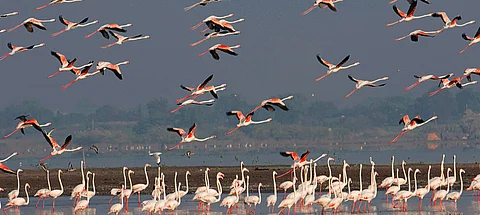
- Destinations
- Experiences
- Stay
- What's new
- Celebrating People
- Responsible Tourism
- CampaignsCampaigns
- SubscribeSubscribe
- Buy Now

The backwater of the Ujni (also Ujjani) Dam on Bhima River, spreads across parts of central Maharashtra in multiple channels. Tucked at the edge of one such channel is Bhigwan, about 250km by road from Mumbai. For the greater part of the year, this nondescript town is frequented only by trucks running to and from the fields, carrying loads of sugarcane, which grow abundantly in the surrounding region. But in winter, it wakes up to the noise of different wheels as birding enthusiasts and photographers descend here for a date with the migratory birds.
Between December and March (depending on the weather and the level of water), the backwater around Bhigwan plays host to a large number of migratory birds, including greater flamingos. It is the presence of a large number of migratory waterfowl that has earned the place the nickname of &lsquoBharatpur of Maharashtra&rsquo (Bharatpur, in Uttar Pradesh is where the UNESCO World Heritage Site Keoladeo Ghana bird sanctuary is situated). Although it is not quite known why the birds chose to come here but the presence of fisheries may be one of the reason.
One of the most popular points is Diksal, about three km from Bhigwan. A narrow road (actually an old bridge) cuts through one of the many channels here making it easy to go birding on foot. Although trucks roar past, the resident birds have mostly got used to it. So don&rsquot be surprised if you find open bill storks sitting within shake hand distance, indifferent to your presence. Or, you may also seek the help of local fishermen who will readily take you on a boat ride for a fee.
But if you want to be away from the noise, then head to Kumbhargaon village on the edge of another channel. About five km from Bhigwan, the village is off the Pune-Solapur highway. Interestingly, while in many places in India, the birds and fishing folk are at loggerheads, in Kumbhargaon, the local people have taken to protecting the birds. Some of the fishermen have trained themselves as birding guides and offer visitors a ride in their boats for a fee.
The row boats allow you to approach the birds silently. Common birds seen during a typical boat trip may include gulls, black winged stilts, herons, open bill and painted storks, river terns, various kinds of kingfishers, common coot, godwits, and various kinds of migratory ducks.
But what most people eagerly wait for is the sight of the greater flamingos. As the morning mist lifts over the water and the boat travels to a point that has been dubbed the &lsquoflamingo point&rsquo, you will find the leggy birds, the feather of most a bright pink, foraging among the shallow water. Sometimes, they rise in unison to wheel beneath the blue sky before settling down some distance away.
However, pray that no boat load of over enthusiastic photographers are in the vicinity. Because in their eagerness to get close to the birds, they often end up disturbing them.
Boat rides are usually conducted early in the morning and late in the afternoon and last for two to three hours.
Getting There You can drive to Bhigwan from Pune or Mumbai. Solapur-bound ST buses from Pune are best avoided unless you want to keep the costs low. Diksal is about 8km from Bhigwan village. Kumbhargaon is at the end of a service road off the Pune-Solapur Road.
Where to stay Baramati, an industrial town, about 25km from Bhigwan, is the best place to stay. Some of the fisher folk have also started home stay on their premises. If you are fancy free and want to stay close to the birding spots for an early start, these homestays are rather convenient. You may check with Sandeep Nagare (tel 91-8975-017405, 91-99606-10615) for home stay and boating facility.
